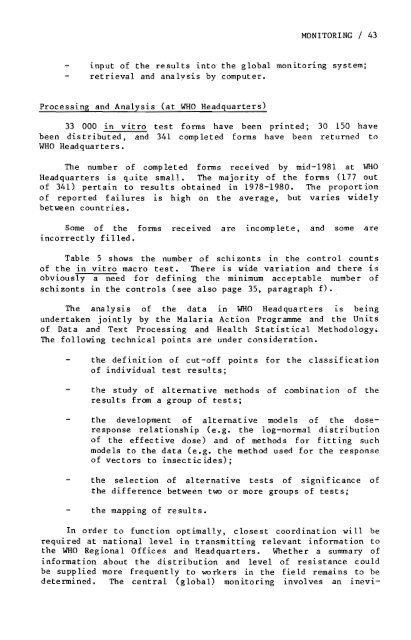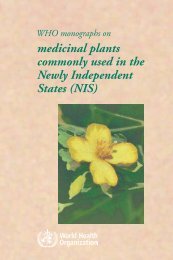Drug-Resistant Malaria - libdoc.who.int - World Health Organization
Drug-Resistant Malaria - libdoc.who.int - World Health Organization
Drug-Resistant Malaria - libdoc.who.int - World Health Organization
Create successful ePaper yourself
Turn your PDF publications into a flip-book with our unique Google optimized e-Paper software.
MONITORING / 43<br />
input of the results <strong>int</strong>o the global monitoring system;<br />
retrieval and analysis by computer.<br />
Processing and Analysis (at WHO Headquarters)<br />
33 000 in vitro test forms have been pr<strong>int</strong>ed; 30 150 have<br />
been distributed, and 341 completed forms have been returned to<br />
WHO Headquarters.<br />
The number of completed forms received by mid-198l at WHO<br />
Headquarters is quite small. The majority of the forms (177 out<br />
of 341) pertain to results obtained in 1978-1980. The proportion<br />
of reported failures is high on the average, but varies widely<br />
between countries.<br />
Some of the forms received are incomplete, and some are<br />
incorrectly filled.<br />
Table 5 shows the number of schizonts in the control counts<br />
of the in vitro macro test. There is wide variation and there is<br />
obviously a need for defining the minimum acceptable number of<br />
schizonts in the controls (see also page 35, paragraph f).<br />
The analysis of the data in WHO Headquarters B being<br />
undertaken jo<strong>int</strong>ly by the <strong>Malaria</strong> Action Programme and the Units<br />
of Data and Text Process i ng and <strong>Health</strong> S tat is t ical Methodology.<br />
The following technical po<strong>int</strong>s are under consideration.<br />
the definition of cut-off po<strong>int</strong>s for the classification<br />
of individual test results;<br />
the study of alternati"e methods of combination of the<br />
results from a group of tests;<br />
the development of alternative models of the doseresponse<br />
relationship (e.g. the log-normal distribution<br />
of the effective dose) and of methods for fitting such<br />
models to the data (e.g. the method used for the response<br />
of vectors to insecticides);<br />
the selection of alternative tests of significance of<br />
the difference between two or more groups of tests;<br />
the mapping of results.<br />
In order to function optimally, closest coordination will be<br />
required at national level in transmitting relevant information to<br />
the WHO Regional Offices and Headquarters. Whether a summary of<br />
information about the distribution and level of resistance could<br />
be supplied more frequently to workers in the field remains to be<br />
determined. The central (global) monitoring involves an inevi-
















